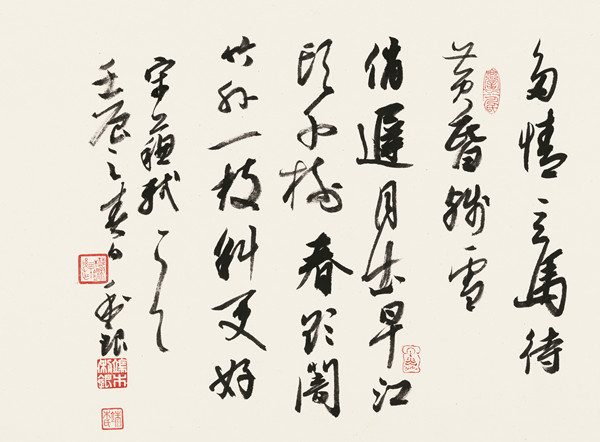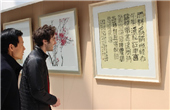The impact of calligraphy on Chinese culture
china.org.cn / chinagate.cn, April 28, 2015 Adjust font size:

A piece of Duanmu Liyin's calligraphy work
On the other hand, cursive and semi-cursive are both drawn in flowing strokes where the pen often doesn't leave the paper. There is a word in Chinese to describe this called lian bi (连笔), which means a movement of the brush that links multiple strokes of a character. The cursive styles with lian bi are more flowing and impressionistic, less distinct. The characters look like they are moving, which could explain why semi-cursive is translated directly as "running script," and cursive is "grass script." It looks like blades of grass blowing in the wind.
Duanmu said, "The difference between semi-cursive and cursive is that cursive is written especially quickly. Semi-cursive also has lian bi, but it doesn't have as many lian bi as cursive does."
Finally, the oldest style of calligraphy still in wide usage is seal script (zhuan shu). It was the first style of writing used officially under the Qin, the first dynasty. It is has especially curved strokes, kind of like the original oracle bone script. Even a lot of Chinese people can't recognize it. Older yet is the oracle bone script, written on divinatory bones more than 3000 years ago, which some calligraphers still practice.
The content displayed in calligraphy is often ancient poems or Buddhist canon. Among the works Duanmu displayed was one of the Heart Sutra and one of a Tang dynasty poem. Some of the calligraphy was drawn alongside paintings of mountains and birds, but most of it was on blank pages. The addition of seals is also an important part of calligraphy, not just to identify the artist, but also to add meanings to the works. The Buddhist sutras included Buddhist seals, and one work displayed a dozen different seals.
The continuing practice of calligraphy will keep Chinese culture alive and inspire foreigners to learn Chinese.
The author is a columnist with China.org.cn. For more information please visit: http://www.china.org.cn/opinion/MitchellBlatt.htm
Opinion articles reflect the views of their authors, not necessarily those of China.org.cn.

